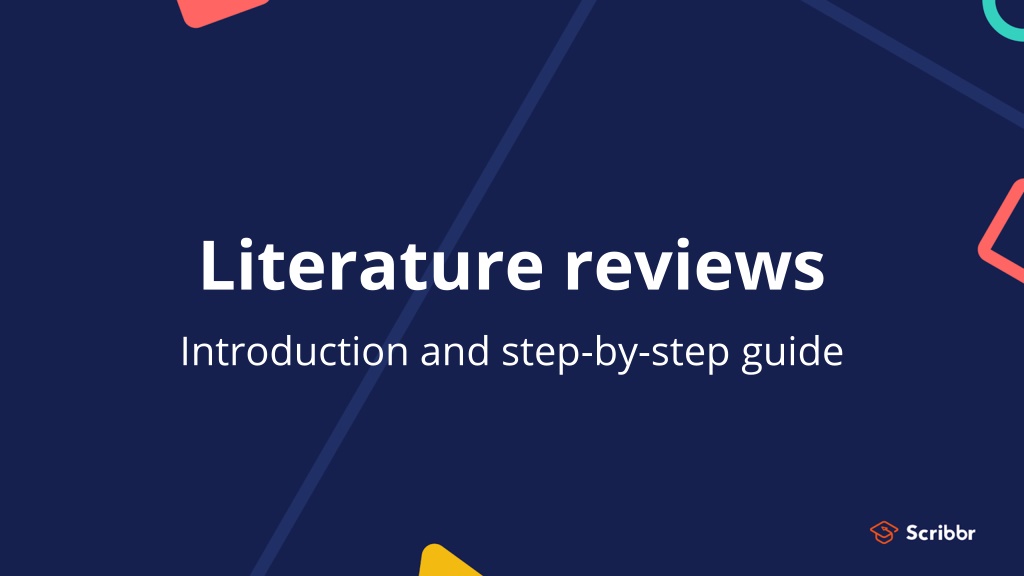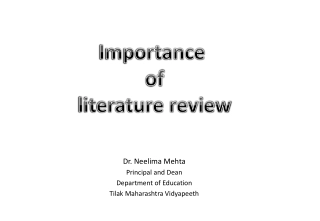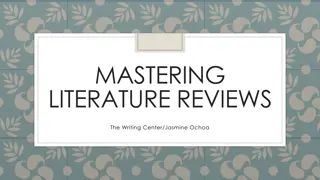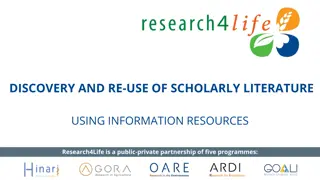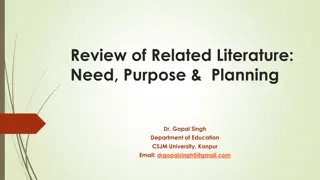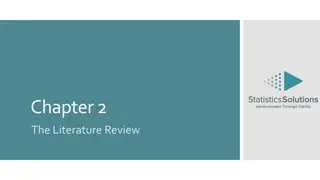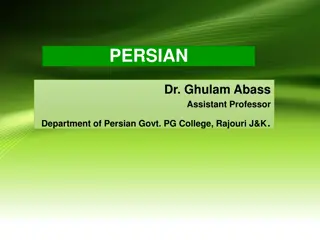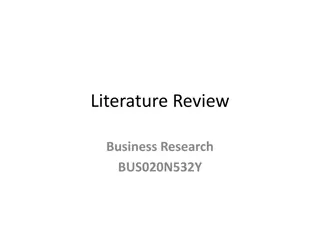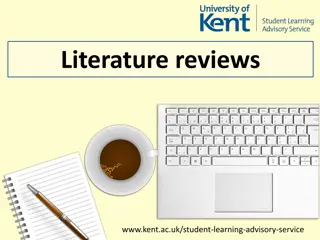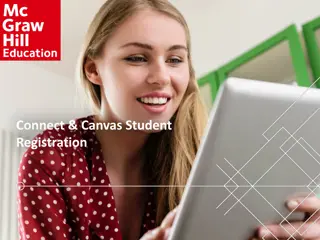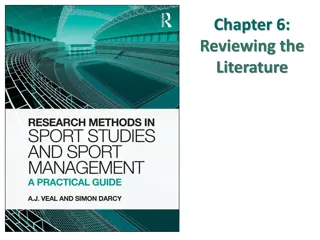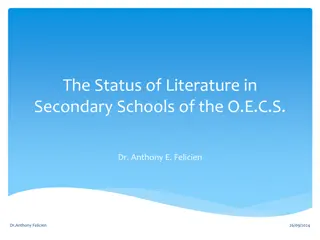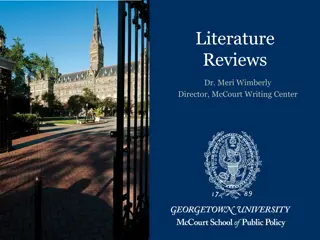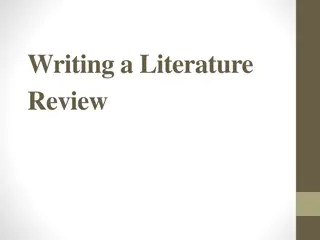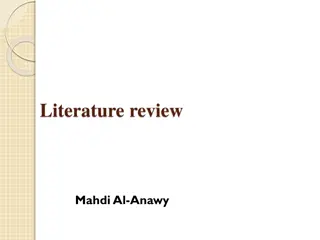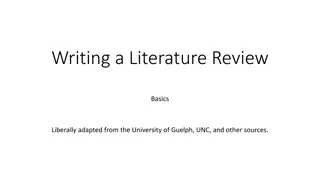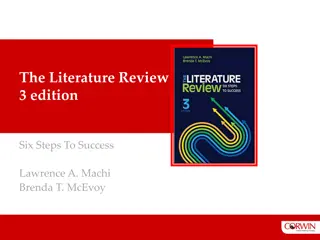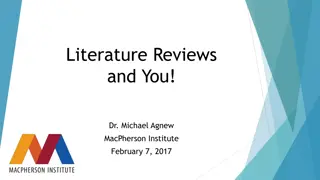Ultimate Guide to Conducting a Literature Review: Step-by-Step Approach
Unlock the secrets of crafting a comprehensive literature review with this in-depth guide. From understanding the purpose to practical steps like searching for relevant literature and defining research problems, this resource covers it all.
Download Presentation

Please find below an Image/Link to download the presentation.
The content on the website is provided AS IS for your information and personal use only. It may not be sold, licensed, or shared on other websites without obtaining consent from the author. Download presentation by click this link. If you encounter any issues during the download, it is possible that the publisher has removed the file from their server.
E N D
Presentation Transcript
Literature reviews Introduction and step-by-step guide
A literature review... Surveys scholarly sources on a specific topic Provides an overview of current knowledge Points out gaps in existing research Appears as part of a dissertation or on its own
Purpose of the literature review Demonstrate familiarity with the topic and scholarly context Develop a theoretical framework and methodology Position your approach in relation to other researchers Show how your research fits in
Conducting a literature review: 5 steps
How to Write a Literature Review: 3 Minute Step-by-step Guide | Scribbr ? Don't know how to write a literature review or where to begin? This video will give you a quick run-through of the 5 steps you need to follow when writing a literature review explained in less than 3 minutes! Intro - 0:00 1. Search for relevant literature - 0:30 2. Evaluate and select sources - 0:58 3. Identify themes, debates, and gaps - 1:26 4. Outline your literature review's structure - 1:56 5. Write it - 2:34 Check out our literature review playlist here http://tiny.cc/b96zmz Check out other Scribbr Knowledge Base articles here https://www.scribbr.com/knowledge-base/ *************************************************** Academic Writing Resources: APA Citation Generator https://www.scribbr.com/apa-citation-generator/ Plagiarism Checker https://www.scribbr.com/plagiarism-checker/ Proofreading Editing Service https://www.scribbr.com/proofreading-editing/ **************************************************** CONNECT WITH US: Scribbr https://scribbr.com YouTube https://www.youtube.com/channel/UCrDcofIg9AJ3Ky3BGuMnqqw?sub_confirmation=1 Instagram https://www.instagram.com/scribbr_/
Step 1 Search for relevant literature
Defining your research problem Effects of social media Social media & body image Social media & body image among Gen Z What is the impact of social media on body image among Generation Z?
Identifying keywords Social media, Facebook, Instagram, Twitter, Snapchat, TikTok Body image, self-perception, self-esteem, mental health Generation Z, teenagers, adolescents, youth
Where to search Your university s library catalogue Google Scholar JSTOR EBSCO Project Muse (humanities and social sciences) Medline (life sciences and biomedicine) EconLit (economics) Inspec (physics, engineering and computer science)
Searching efficiently Use boolean operators (AND, OR, NOT) Read abstracts Check bibliographies for more sources Note recurring citations
Step 2 Evaluate and select sources
Questions to ask about sources What question is addressed? What are the key concepts? What are the key theories and methods? What are the results and conclusions? How does it relate to other studies? What are the key insights and arguments? What are the strengths and weaknesses of the research?
Taking notes Quotes Summaries of key points Source information: Author name Title & journal name Year of publication Page numbers
Step 3 Identify themes, debates, and gaps
What to look for Trends in the literature over time Key themes Debates and disagreements Pivotal publications Research gaps
Examples of trends and gaps Most research focused on young women Increasing interest in the visual aspects of social media Lack of research on platforms like Instagram and Snapchat This is a gap your research could fill
Step 4 Outline your structure
Common structures Chronological: Thematic: Methodological: Theoretical: approach Organize by time Organize by theme Organize by methodology Organize by theoretical
Outline Your Literature Review's Structure | Scribbr ? Before you start writing, it's good to have an outline of your literature review's structure. In this video, you'll learn 4 common approaches to organize the body of your literature review. Subscribbr https://www.youtube.com/scribbrus?sub_confirmation=1 Intro and topic recap - 00:00 1. Chronological - 0:39 2. Thematic - 1:17 3. Method - 1:41 4. Theory - 2:01 *************************************** Additional Resources Check out our literature review playlist here https://www.youtube.com/playlist?list=PLjBMY3HggCpCEpa2VIXXM1udk9kcknahX Check out other Scribbr Knowledge Base articles here https://www.scribbr.com/knowledge-base/ *************************************************** Academic Writing Resources: APA Citation Generator https://www.scribbr.com/apa-citation-generator/ Plagiarism Checker https://www.scribbr.com/plagiarism-checker/ Proofreading Editing Service https://www.scribbr.com/proofreading-editing/ **************************************************** CONNECT WITH US: Scribbr https://scribbr.com YouTube https://www.youtube.com/channel/UCrDcofIg9AJ3Ky3BGuMnqqw?sub_confirmation=1 Instagram https://www.instagram.com/scribbr_/
Step 5 Write your literature review
Format of a literature review 1. Introduction establishing purpose 2. Body analyzing the literature 3. Conclusion summarizing key findings
The introduction Stand-alone literature review: Provide background on the topic Describe the objectives of the literature review Dissertation, thesis, or research paper: Reiterate the central problem Briefly summarize the scholarly context
The body May be divided into sections Analyze and interpret Critically evaluate Synthesize different sources Use well-structured paragraphs Cite your sources
4 TIPS for Writing a Literature Review's Intro, Body Conclusion | Scribbr ? Just like any other academic text, your literature review should have an introduction, a main body, and a conclusion. In this video, you ll learn what to include in each section, as well as 4 tips for the main body illustrated with an example. Subscribbr https://www.youtube.com/scribbrus?sub_confirmation=1 Intro - 0:00 General structure - 00:10 Introduction - 00:17 Body - 1:10 4 Tips for main body - 1:31 1. Summarize synthesize - 1:39 2. Analyze and interpret - 2:18 3. Critically evaluate - 2:42 4. Use well-structured paragraphs - 3:00 Conclusion - 3:21 Before submitting - 3:44 **************************************************** Additional Resources Check out our literature review playlist here https://www.youtube.com/playlist?list=PLjBMY3HggCpCEpa2VIXXM1udk9kcknahX Check out other Scribbr Knowledge Base articles here https://www.scribbr.com/knowledge-base/ *************************************************** Academic Writing Resources: APA Citation Generator https://www.scribbr.com/apa-citation-generator/ Plagiarism Checker https://www.scribbr.com/plagiarism-checker/ Proofreading Editing Service https://www.scribbr.com/proofreading-editing/ **************************************************** CONNECT WITH US: Scribbr https://scribbr.com Subscribbr https://www.youtube.com/scribbrus?sub_confirmation=1 Instagram https://www.instagram.com/scribbr_/
The conclusion Stand-alone literature review: Discuss the overall implications Make suggestions for future research Dissertation, thesis, or research paper: Show how the literature review has informed your approach State what gaps your research will address
Recommended resources
Free Scribbr resources Knowledge Base (300+ articles) Citation Generator YouTube Channel
Hi, were Scribbr We are a team of 60 people in Amsterdam, and we partner with more than 500 freelance editors across the globe to help students graduate and become better academic writers. Every day, we work hard on our Proofreading & Editing service, Plagiarism Checker, Citation Generator, Knowledge Base and educational YouTube channel.
Guidelines for using this presentation This presentation can be freely used and modified for educational purposes. You may: Display this presentation in a classroom environment Modify or delete slides Distribute this presentation in print or in private student environments (e.g. Moodle, BlackBoard, Google Classroom) Please do give credit to Scribbr for creating this resource. Questions or feedback? Email shona@scribbr.com and we ll be in touch!
